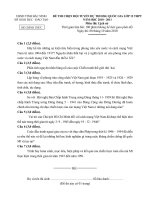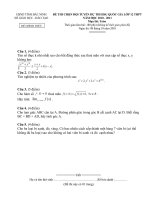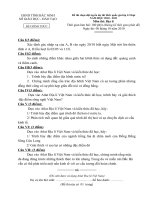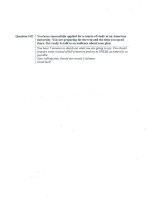Đề +ĐA chọn HSGQG môn -Tiếng AnhBN-2010-2011
Bạn đang xem bản rút gọn của tài liệu. Xem và tải ngay bản đầy đủ của tài liệu tại đây (187.35 KB, 12 trang )
UBND TỈNH BẮC NINH
SỞ GIÁO DỤC - ĐÀO TẠO
Đề thi chọn đội tuyển dự thi HsG quốc gia lớp 12 thpt
NĂM HỌC 2010 - 2011
Mụn thi: Tiếng Anh
Thời gian làm bài: 180 phỳt (không kể thời gian phát đề)
Ngày thi: 08 tháng 10 năm 2010
==========
Điểm bài thi: Bằng số ………… Bằng chữ………………………
Chữ ký của người chấm thi:
Số 1 ………………………………………..
Số 2: ……………………………………….
(Thớ sinh làm bài trực tiếp trên đề thi)
SECTION I. PHONOLOGY (20 PTS)
Part I. Find the word whose bold part is pronounced differently. Circle the letter preceding the
correct answer (A, B, C or D). (10 pts)
1. A. manufacture B. mature C. pasture D. agriculture
2. A. explanation B. preparation C. observatory D. cooperation
3. A. southern B. mathematics C. breathe D. trustworthy
4. A. sergeant B. servant C. service D. sermon
5. A. recite B. reconcile C. refund D. reproduce
6. A. foot B. stood C. wood D. food
7. A. explosion B. exploration C. expertise D. expedition
8. A. chooses B. increases C. releases D. practises
9. A. procedure B. programme C. progress D. profile
10. A. sacred B. embedded C. ragged D. shrugged
Part 2. Identify the word whose stress pattern is different from that of the other words in the same
group. Circle the letter preceding the correct answer (A, B, C or D). (10 pts)
1. A. trigonometry B. explanatory C. immediately D. democracy
2. A. argumentative B. psychological C. contributory D. hypersensitive
3. A. assassinate B. equality C. intelligence D. understanding
4. A. majority B. ceremony C. astronomy D. opinion
5. A. managerial B. determination C. unbelievable D. inability
6. A. tropical B. commercial C. disastrous D. extensive
7. A. experience B. hurricane C. volcano D. material
8. A. accept B. unique C. successful D. laughter
9. A. independence B. politician C. immortality D. socialism
10. A. confer B. offer C. prefer D. deter
SECTION II: LEXICO – GRAMMAR. (45 PTS)
Part 1: Choose the word or phrase that best completes each sentence. Circle the letter preceding the
correct answer (A, B, C or D). (5 pts)
1. Thousands of _______ are already signing up for this new telephone service.
A individuals B subscribers C applicants D interviewees
2. This is a _______ example of what not to do.
A critical B pure C simple D prime
3. Job losses are mainly in the _______ sectors of the industry.
A blue-collar B red-collar C stiff-collar D high-collar
4. Unfortunately she has been given an _______ task.
A insurmountable B undeveloped C inoperable D unsolved
5. It was a big _______ for her to give up her acting career to look after her family.
A trial B sacrifice C endeavour D test
PAGE 1 OF 8
ĐỀ CHÍNH THỨC
Số phách (do CT hội đồng ghi)
6. They are showing a _______ of a 1930’s musical at the Theatre Royal.
A resurrection B revival C retake D repeat
7. The students at this university are _______ in blocks of flats on the campus.
A housed B domiciled C resident D placed
8. I have no wish to have any _______ with a firm like that.
A openings B handling C dealings D contacts
9. Voters find it difficult to believe politicians because the latter use so many _______ doctors.
A twist B spin C turn D spinning
10. We are told there will be little economic _______ this year.
A progress B forwards C movements D progression
Part 2: Use the correct form of the words given in brackets to fill in the space. (5 pts)
1. Human beings are the worst (pollute)_______________ on earth.
2. No one can understand Lewis’s behaviour. It’s (explain)_______________.
3. She is very efficient, and (fail)_______________ polite to customers.
4. I have always (envious)_______________ your lifestyle.
5. After the (taking)_______________ several employees lost their jobs.
6. The cost of (carry)_______________ must be paid by the buyer.
7. Diseased cells must be killed while their neighbours are left (harm)_______________.
8. Nobody gets (prefer)_______________ treatment in this office.
9. People used to suffer from life-time physical (normal)_______________.
10. She died in (child)_______________.
Part 3: The passage below contains 10 mistakes. Find them and correct them. Write your answers
in the space provided below the passage. (10 pts)
As we feel tired at bed-time, it is natural to assume that we sleep because we are tired. The point
seems so obviously that hardly anyone has ever sought to question it. Nevertheless, we must ask “tired of
what?” People certainly feel tired in the end of a hard day’s manual work, but it is also true that office
workers feel equally tired when bed-time come. Even invalids, confined to beds or wheelchairs, become
tired as the evening wears on. Moreover, the manual workers will still feel tired even after an evening
spent relaxing in front of the television or read a book, activities which ought to have a refreshing effect.
There is no proof connection between physical exertion and the need for sleep. People want to sleep,
however little exercises they have had. Nor is the desire for sleep relating to mental fatigue. In fact, sleep
comes more slowly to people who have had an intellectual stimulating day, just because their minds are
still full in thoughts when they retire. Ironically, one way of sending someone to sleep is to put him or
her into boring situation where the intellectual effort is minimal.
Your answers:
1. __________________ __________________ 6. __________________ __________________
2. __________________ __________________ 7. __________________ __________________
3. __________________ __________________ 8. __________________ __________________
4. __________________ __________________ 9. __________________ __________________
5. __________________ __________________ 10. __________________ __________________
Part 4: Put the verb in parentheses in the correct tense or form. The word in italics should be put in
the correct position in relation to the verb. (10 pts)
Though Brazil is one of the richest countries in the world, much of it
1
(not yet develop)___________.
It
2
(be)_________ mainly for this reason that the Brazilian government
3
(decide)___________ to have a
new city
4
(build)___________ 600 miles north-west of Rio de Janeiro.
5
(design)___________ by the
great architect Lucio Costa, the new city, Brasilia,
6
(replace)____________ Rio de Janeiro as the capital
of Brazil in 1960. Brasilia carefully
7
(plan)___________ for modern living. Its wide roads, which
8
(can
take)______________ fourteen lanes of traffic,
9
(keep)___________ away from living areas. Children
10
(not have to cross)____________ busy streets
11
(go)____________ to school. Housewives
12
(can
PAGE 2 OF 8
visit)____________ shopping centres on foot, for in these specially
13
(design)____________ living
areas, cars
14
(be) ______________ unnecessary. At first, the government
15
(have)____________ great
difficulties in
16
(persuade)_____________ people to leave Rio and
17
(settle)____________ in Brasilia.
Since 1960, however, the population
18
(grow)____________ all the time. Brasilia quickly
19
(establish)_____________ itself as the capital of the country. The idea to have the capital moved so far
inland
20
(have)_____________ a great effect on the future of Brazil.
Your answers:
1. _________________ 6. _________________ 11. _______________ 16. ________________
2. _________________ 7. _________________ 12. _______________ 17. ________________
3. _________________ 8. _________________ 13. _______________ 18. ________________
4. _________________ 9. _________________ 14. _______________ 19. ________________
5. _________________ 10. ________________ 15. _______________ 20. ________________
Part 5: Insert a, an, the or ỉ (no article) in each of the numbered blanks. (5 pts)
A lot of pressures are encouraging you to worry about your appearance. Women’s magazines, (1)
______ advertisements and (2) ______ media all concentrate on (3) ______ subject, and they bombard
you with (4) ______ warnings about (5) ______ bad breath, perspiration, being too fat or too thin. They
even give (6) ______ impression that if you use (7) ______ certain shampoo or cosmetic, you will
become attractive to (8) ______ boys. Your parents may become involved in this process by encouraging
you to think about your appearance, and your friends may create (9) ______ atmosphere of (10) _______
competition.
Part 6: Fill in each gap with a suitable preposition. (10 pts)
The star (1)_______ the largest scale opera performance over staged (2)_______ Britain pull out
(3)_______ its opening night (4)_______ Sunday. Yerdi’s Aida is being performed (5)_______
London’s Earl’s Court Arena (6)_______ a cast of 600 singers, dancers and actors. American soprano
Grace Bumbry (7)_______ the title role was suffering (8)_______ hay fever, but had promised to be “ all
right on the night even if my nose drops like the Nile”. Half way (9)_______ the performance she was
unable to continue and was replaced (10)_______ mid-performance (11)_______ Russian soprano
Ghena Dimitrova who was sitting (12)_______ the audience watching the show . She was taken
(13)_______ a dressing room where she put on Ms Bumbry costume and was made up. She was ready to
go (14)_______ the stage (15)_______ a longer than usual interval.
Tuesday’s performance (16)_______ the presence (17)_______ the Prince and Princess of Wale will
go ahead (18)_______ Ms Bumbry- her role will be taken (19)_______ Martina Arroyo (20)_______
Italy.
SECTION III. READING. (65 PTS)
Part 1: Read the following passage and circle the letter preceding the correct answer (A, B, C, or D)
which best fits each gap. (15 pts)
TWO CREATURES OF THE PAST - MAMMOTHS AND MASTODONS
The elephant has some distant relatives called mammoths, which lived in the Stone Age. More than
15,000 years ago people painted pictures of them on cave walls. Then, astonishingly, in 1799, a man
walking along the banks of the River Lena in Siberia (1)_______ a starting discovery. Peering into a wall
of ice, he could (2)_______ see the shape of a massive, hairy mammoth, apparently (3)_______. He
immediately ran (4)_______ in terror, but several days later he (5)_______ the courage to return and cut
the mammoth’s tusks - its two enormous teeth - out of the ice to sell them. Mammoth tusks are the
biggest teeth of any known creature, some (6)_______ a length of five meters. These tusks were
(7)_______ to good use, protecting the mammoths’ young from other animals, and brushing away snow.
To most of us, mammoths are probably the most (8)_______ of the elephant’s extinct relatives, but
thousands of years earlier, in the woodlands of eastern North America, lived another of the elephant’s
PAGE 3 OF 8
relatives called the mastodon. Like mammoths, mastodon may also have had a hairy coat, but
(9)_______ mammoths mainly ate grass on the plains, mastodons (10)_______ to eat twigs and leaves.
We do not know why mastodons (11)_______ extinct. However, computer studies of the decrease in
mammoth (12)_______ suggest that it was a particular (13)_______ of over-hunting by humans, and
(14)_______ in the climate at that time which (15)_______ to their disappearance.
1. A. made B. took C. did D. had
2. A. rather B. quite C. just D. well
3. A. watching out B. watching over C. looking after D. looking out
4. A. across B. away C. out D. past
5. A. grew B. felt C. found D. experienced
6. A. increasing B. reaching C. expanding D. completing
7. A. put B. held C. set D. kept
8. A. usual B. frequent C. regular D. familiar
9 A. when B. while C. as D. even
10. A. preferred B. enjoyed C. desired D. selected
11. A. turned B. went C. became D. came
12. A. quantities B. amounts C. totals D. numbers
13. A. combination B. addition C. attachment D. connection
14. A. transformations B. changes C. diversions D. adjustments
15. A. guided B. caused C. led D. influenced
Part 2: Read the following passage and circle the correct answer (marked A, B, C, or D) to each of
the questions that follow. (20 pts)
My lawyer, Mr. Turner, is the only man I know who has seen a ghost. He is a quiet even-tempered
man whose life is spent in dealing with facts. He is the last person in the world to give way to fantasy.
He has a wife and two children of whom he is proud, takes a modest holiday abroad every year and
spends his Sundays gardening. He is knowledgeable about art and architecture, though he doesn't pretend
to be an expert by any means. It is, therefore, all the more surprising that he should so insistent about the
ghost. It happened, so he says, like this:
He was travelling from London to the North of England by train. It was a misty November evening
and the train was half empty. In fact for the first part of the journey Mr. Turner had the carriage to
himself and sat dozing over a newspaper. However at the first stop a passenger jumped in, slamming the
door behind him. He seemed out of breath as if he had been running. He was a striking looking young
man with dark, bushy hair and bright intelligent eyes. He was dressed rather oddly in a long waisted coat
with silver buttons, tight trousers and an embroidered waistcoat. Mr. Turner did not pay much attention
to this because people wear all sorts of extravagant clothes these days and he had long grown
accustomed to them.
Presently, the two men got into conversation, as people do on long journeys. Mr. Turner was
interested to cover that the young man was very knowledgeable about Art - in particular portraits. His
name, he said, was Joseph Hart, and he was on his way to visit an exhibition. It seemed that he worked in
a famous London Art Gallery - a picture restorer, perhaps, thought Mr. Turner, for he seemed to know a
great deal about varnishes and paints, and even more about the subjects of certain portraits. When Mr.
Turner asked his opinion of the portrait of a famous judge by an artist he admired, his companion
laughed and said, “He’s only a reproduction - a good one I agree but you can't talk to a reproduction.”
He spoke as though the person in the portrait were still living.
After a while the carriage got hot and steamy and Mr. Turner dropped off. He woke up just as the
train was drawing up at a junction with a grinding of brakes. His companion had disappeared.
A few days later, having returned to London, Mr. Turner found himself near the Art Gallery. Moved
by some impulse, he went in and enquired for Joseph Hart. The attendant directed him to a room devoted
to early nineteenth century portraits of well-known men. There was no-one in the room and Mr. Turner
looked about him. Without knowing quite how he had got there, he found himself standing in front of a
full-length portrait of a dark young man in tight trousers and an embroidered waistcoat. The eyes smiled
at him with a hint of amusement. The name-plate at the foot of the picture read: Joseph Hart,
Gentleman, 1800-1835.
PAGE 4 OF 8
1. What kind of person was Mr. Turner?
A. imaginative B. fantastic C. sensible D. insensitive
2. Although he was a lawyer, Mr. Turner _______.
A. pretended to know a lot about Art. B. knew something about Art.
C. pretended to take an interest in Art. D. intended to learn more about Art.
3. When the passenger entered Mr. Turner’s compartment _______.
A. he was painting. B. he was running.
C. the train was just leaving. D. the carriage was half-empty.
4. The passenger’s clothes didn’t seem strange to Mr. Turner because _______.
A. he was used to wearing strange clothes. B. he liked people who wore strange clothes.
C. everyone he knew wore strange clothes. D. he had seen a lot of people in strange clothes.
5. Mr. Turner thought the young man might _______.
A. be an Art Dealer. B. be an Art Expert.
C. renew old pictures. D. paint reproductions of old pictures.
6. Why wouldn’t the passenger give an opinion on the portrait of the judge?
A. the judge wasn’t alive. B. the judge was still alive.
C. the picture was a copy. D. he hadn’t seen it.
7. When did Mr. Turner first realize that the passenger had gone?
A. When the train started. B. After the train had stopped.
C. Just before the train stopped. D. When the train was leaving the station.
8. Why did Mr. Turner go into the Art Gallery?
A. He was walking past there. B. He had never been there before.
C. He had planned to do so. D. He suddenly decided to.
9. In the past of the gallery that Mr. Turner was directed to _______.
A. there were a lot of pictures by unknown people.
B. there were a lot of nineteenth century people.
C. no-one else was looking at the pictures.
D. he only saw one portrait.
10. When Mr. Turner looked at the portrait of Joseph Hart _______.
A. he smiled at it. B. he thought it smiled at him.
C. he didn’t recognize it. D. he was amused.
Part 3: Fill each numbered blank in the following passage with one most suitable sentence given in
the list below. (10 pts)
Food is one of the things we notice about different cultures. It is also one of the first aspects of a
different culture we feel to adopt. The table manners that accompany the food are not so obvious. When
the behaviors of a culture are visibly in contrast, they are most powerful, even when we are not aware of
them. (1)_______.
In Australia, it is expected that everyone will talk during a meal. The talking passes from one person
to another and is often about an issue that has been in the news, a new movie, or some other neutral and
safe topics. (2)_______. Conversation is held before or after the meal itself.
(3)_______. In Australia, when we have finished eating the main course we put the knife and fork
across the middle of the plate parallel to each other with the handles facing towards us. When we are
resting during the meal, we put the knife and fork across each other on the middle of the plate.
(4)_______. In Indonesia, some students tell me, the fork and the spoon are crossed as in Australian
resting position. But not all Indonesians may do this. Indonesia is itself a very multicultural society, so
there may be a number of customs for this within the country.
Consider further where the dishes are positioned on the table. The Chinese custom of all the diners
eating from a range of central dishes is different from the Western way of having servings on separate
plates. (5)_______. Even the way knives and forks fence in the plates makes a little frame for the plate
and defines separate arenas of action all around the table, rather than one common arena of action as is
the case of cultures where all the diners share from the common dishes.
A. After the meal, the way we place our eating tools, our knives, forks, or chopsticks, is also culturally
defined.
PAGE 5 OF 8









